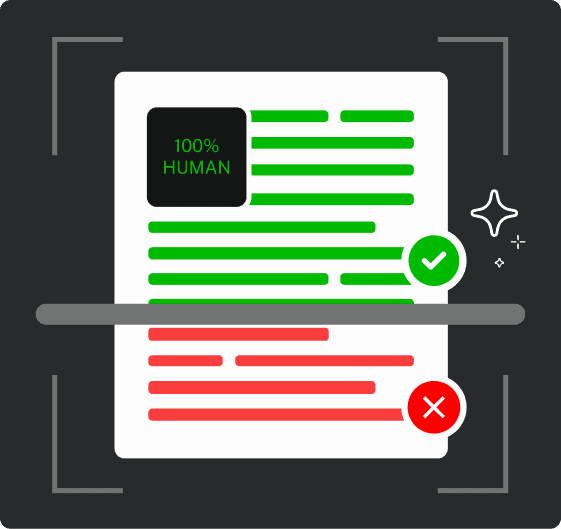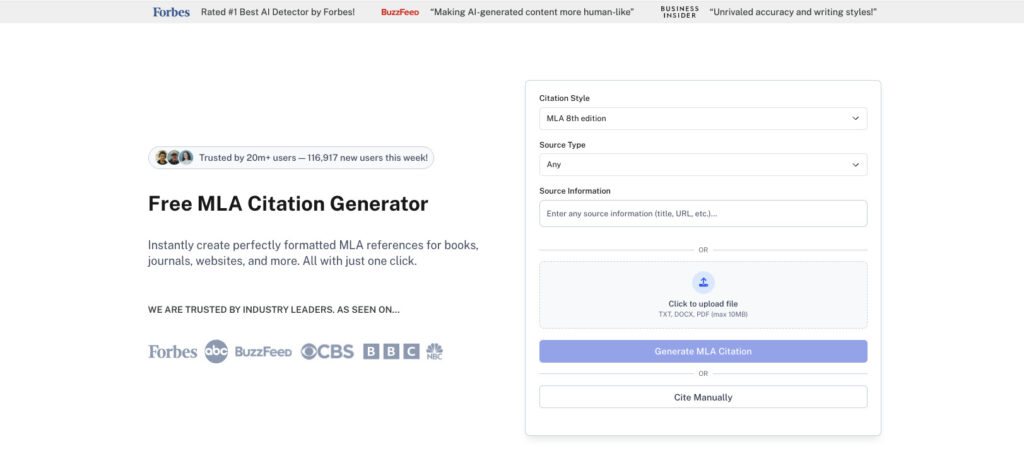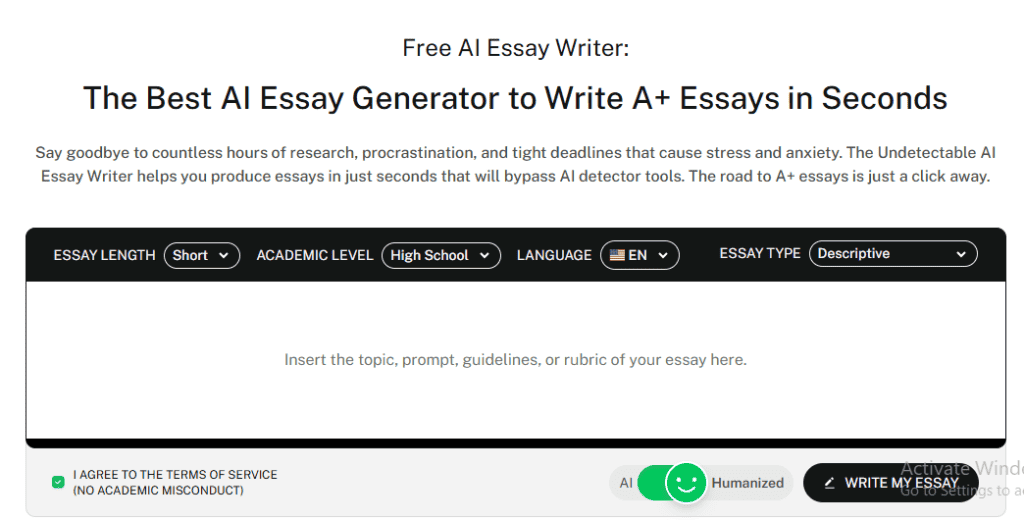One of the most used formatting styles in the humanities field is the MLA style guide, which is popular among students, seasoned researchers and other academics.
This article gives a guide to the basics of the MLA format.
Have you been wondering what is MLA Format?
Below, you’ll find our breakdown of in-text citations, works cited entries and other useful tips.
Keep reading to get started.
Key Takeaways
- MLA format is widely used in humanities for consistent structure, citations, and style.
- Key MLA page settings include 1-inch margins, double spacing, and 0.5-inch indents.
- The first page includes your name, instructor, course, and date, with the title centered.
- In-text citations use author-page format; block quotes apply to texts over four lines.
- Works Cited pages list all sources alphabetically with hanging indents and double spacing.
- MLA differs from APA and Chicago, which are suited to science and historical writing.
What Is MLA Format?
MLA stands for Modern Language Association format. In the late 18th century, the Modern Language Association was introduced with resources and style guides for scholars in the humanities field.
It involves standardized guides on how to cite sources, style and the other essential elements that form academic writing.
Key Components of MLA Format
The MLA Format provides academic writers with a specific guide for the appearance, structure, and format of essays and papers.


Never Worry About AI Detecting Your Texts Again. Undetectable AI Can Help You:
- Make your AI assisted writing appear human-like.
- Bypass all major AI detection tools with just one click.
- Use AI safely and confidently in school and work.
In this section, we will help you understand the core components to ensure your work meets academic standards.
- Page Format
Under the MLA format, you’re not only focused on how to cite your authors properly; you also need to be particular about how your entire work appears on the page of your document.
It helps your readers, including students or teachers, understand your work and ensures consistency across all your papers.
Below are the key formatting requirements under the MLA guide:
- Font: You may be trying to figure out what font is MLA format? MLA does not have specific rules for which font to use. According to the guide, you’re to use a clear, uncomplicated bold font like Arial, Times New Roman or Calibri. If you prefer, size 12 can be used as well and when using italics, be sure they look set apart from the rest of the text.
- Line Spacing: Double Spacing for the entire document
- Margin: Inch margin
- Indentation: 0.5 inch indent for the first word of every paragraph.
- First Page & Title
According to MLA rules, you’re to start the header 1 inch from the top and center it against the left margin of the page.
Later, you should enter your name, your instructor’s name, the course number and the date of the exam. Then, the document uses double spacing after each line.
Add an extra double space and put the title in the center.
The MLA format recommends not to underline, bold or capitalize the title. Also, you can place your authors and source names in italics in the paper’s title.
Always apply the title case style when making your title and add your subtitle on the next line after your main title when one is needed.
- Header & Page Number
In the MLA style, if you are using running heads, use the Author’s last name and the page number. A running head appears at the top right corner of every page in the document.
Be sure not to write “page” or “pp” or “p” in your reference. It is also important to include the page number in the manner it is required.
You can just type your last name, add a space and then the page number.
Example:
Morrisson 44
As a rule, the running head starts on the second page, but you can use the directions given by your supervisor.
If not, there’s no need to put it on the first page; just begin on the following page and keep it all the way through the document.
- Word Count
There is no specific word count for papers under the MLA style guide.
However, the guide provides a minimum and maximum word count length for undergraduate and graduate theses.
You can use our Undetectable AI’s AI Word Counter to edit your work into a specific word length or formatting standard.

In-Text Citations in MLA Format
It is important to never present as your own something that was written by someone else.
Authors own the words they originally use in their work and you must always give credit where you cite a third party in your work.
However, you’re not expected to use quotes throughout the whole essay or write-up.
Here are different ways to include an in-text citation in your MLA paper.
Block Quote
When your quote is more than four lines, you can format it under the MLA block quote style guide.
Under MLA format, you need to put a sentence before the quotation that lets the reader know who said it and what it is doing in your paper.
You also need to put a colon at the end of your sentence before the quote to start on a different line.
Next, move all of the quotes to the left margin by ½ inch or use five spaces.
There’s no need to add quotation marks after the final punctuation, but you can add a brief parenthetical citation.
After the quote, the style guide requires writers to close the paragraph by writing a couple of brief lines.
Example:
Malcolm Gladwell in explaining the theory of success suggests that:
The conventional explanation for Jewish success, of course, is that Jews come from a literate, intellectual culture.
They are famously “the people of the book.” There is surely something to that. But it wasn’t just the children of rabbis who went to law school.
They were the children of garment workers. And their critical advantage in climbing the professional ladder wasn’t the intellectual rigor you get from studying the Talmud.
It was the practical intelligence and savvy you get from watching your father sell aprons on Hester Street.
This approach explains that successful people are great observers who are constantly learning and improving upon what they have learned.
Author’s Name
Another step is to use the Author’s name in the sentence as a citation in the prose.
Example:
Chinua Achebe argues that the effects of colonialism led to a breakdown of cultural identity within the Igbo Society. (14)
Parenthetical Citation
The third way is by removing the Author’s name in the sentence as a parenthetical citation.
Example:
Colonialism is a major contributor to the breakdown of authentic cultural identity in African communities. (Achebe 14).
Generally, the MLA format guide supports the use of footnotes and endnotes to reference authors in your work. You can use these when referencing various sources and authors in the body of your paper.
It is also recommended that you include more information that is relevant but doesn’t fit into the main scope of the project.
Works Cited Page in MLA Format

The Works Cited page is always placed at the end of the paper. At this stage, you can collect every source you have cited in your paper.
By accurately referencing each source in detail, readers can find additional resources to expand their knowledge.
Likewise, it means giving credit to and recognizing all the authors, thinkers and researchers who were involved in forming your argument.
Here’s how to format the works cited page below:
- Page Margins: Set all margins at 1 inch from the top, left, bottom, and right of the page.
- Font: Use font size 12 for body and Times New Roman or any clear bold font.
- Title: Put your title “Works Cited,” in the center of the page and do not bold, underline, or italicize the words. Meanwhile, if you used references without actually including them in the text, you can write, “Works Cited and Consulted.”
- Running Head: Leave your running head on the Works Cited page in the top right.
- Entries: Double-space your entries and insert a double space between the heading and the first entry.
- Arrangement: Place all entries alphabetically with the Author’s last name and double-space all entries. Start each entry with the left margin, and if the words fall into the next line, indent the additional words with a 0.5-inch margin.
If you don’t want to spend time memorizing MLA citation rules or risk formatting mistakes, try our MLA Citation Generator.
It’s a fast, reliable way to apply correct MLA citations without second-guessing punctuation, indentation, or source order.

Just enter your source details like the author’s name, title, and publication info and the tool will instantly generate a clean, properly formatted entry ready for your Works Cited page.
Alternatively, you can use our AI Essay Writer to auto-generate accurate MLA citations.
This makes your work easier and also helps you avoid missing any authors or writers that you have cited in your work.

Additionally, the Undetectable AI Humanizer is a helpful tool for editing your bibliography entries and authors’ notes to sound more polished.

MLA Format Examples
Below are ways you can use the MLA format to reference authors in your work:
- Books: For referencing a book under the MLA style guide, the format is:
Last Name, First Name, Book Title, Publisher, and Year - Journal Article: For a Journal article, use the format below
Author(s), Title of the Article, Journal Title, Volume Number, Number, Year, Database Name, DOI or URL. - Website: For a website article, the proper reference is:
Last name, First Name, Title of the Web Page, Website Name, Date of the publication, Year.
Common Mistakes to Avoid in MLA Format
In case you are wondering, what is a MLA format and what mistakes to avoid when using the format, you can learn from the following formatting mistakes under the MLA style guide:
- Using different fonts and font sizes across your work can be confusing and lead to mistakes.
- Improper in-text citations, such as forgetting to use the Author’s name in your work and using the wrong page number
- Excluding your sources from your Works Cited page will be considered a major error under the MLA style guide.
- Using mismatched indents in your work will affect the structure of your work.
MLA Format vs. Other Citation Styles
There are various writing styles involved in academic writing, each with its own distinct format and citation structure.
They include:
- APA Style Guide
The APA format is used primarily by the American Psychological Association for academics in the Fields of Education and Social Sciences. It is mostly used in papers that require the use of data, studies, and recent findings.
Under the APA style guide, you can make your in-text citations using the Author’s last name in addition to the year of publication. Also, when putting together your Reference List, always use titled references.
The APA style also prioritizes using dates, especially the Year, in your reference.
Example:
Achebe, 1974
- Chicago Style
Another format is the Chicago style used by Historians, Publishers, Philosophers, and others in the humanities field.
This is mostly used for lengthy, detailed papers that call for thorough explanations and background.
When citing your sources, you may use footnotes or put a list of references called “Bibliography” at the end of your paper.
For entering the bibliographies, you can either insert them as a footnote or at the back of the page.
Example:
Gladwell recommends the “10,000-hour rule” as a common thread among experts.
Citation: Gladwell, Malcolm Outliers: The Story of Success (New York: Little, Brown) 2008, 45.
Are you eager to learn what is MLA format for an essay? You need to first look at what your instructor or supervisor requires, and then you can pick a format based on that standard.
The MLA format you choose will also depend on the type of article you’re writing.
Sometimes, it can be a little hard to tell the difference between the MLA style guide and various citation styles.
The application of citation styles mainly depends on what your instructor and the purpose for which you’re writing.
However, as a general pointer, citation styles are often used for the following purposes:
- MLA: For analyzing texts, books, and language.
- APA: For papers involving studies, data, and recent findings.
- Chicago: Use for historical papers, thesis, or any project that requires context and a lot of depth.
Practical Tips For Using MLA Format
Here are some practical tips for formatting using the MLA style guide:
- Use the same font consistently throughout your work
- Include your sources as footnotes to help the reader easily verify your references.
- Use a consistent header for your running head and page numbers to ease the structure of your work.
- Always double-check your in-text citations to see if there’s a misspelling, a missing comma, or a formatting error
- Use proper punctuation always, and close every parenthesis with a punctuation mark.
Give our AI Detector and Humanizer a try in the widget below!
FAQs About MLA Format
Is MLA Format Mandatory For all Academic Papers?
No, it is not. The MLA format is mostly among humanities fields like literature, language, and other related studies.
Can I Use Footnotes in MLA?
Yes, the MLA style guide supports footnote references, but always follow what your instructor or editor demands.
How do I Cite an Online Source in MLA?
To cite an online source, use the following format:
Author’s first and last name, Title page, Website, Publication Date, URL
Conclusion
We hope we’ve answered all your questions on what is MLA format.
However, it is always best to adjust these tips to fit your reader’s or instructor’s requests.
You can also use the Undetectable AI’s AI Essay Writer to find sources and properly reference your papers to fit the MLA guide standard.
